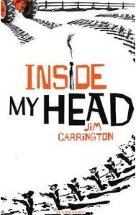Inside my head by Jim Carrington

Bloomsbury, 2010. ISBN: 978140880277.
(Suggested reading age 14-17 years) Recommended. Jim Carrington writes
about adolescent bullying, set in modern rural England using four main
characters. Zoe has recently moved reluctantly from London with her
family and must face the trepidation of starting at a new school.
Knaggs is a nasty, manipulating bully who victimizes Gary over his
appearance, social position, accent and any minute detail which gives
him an opportunity to torment. David is Knaggs' friend who initially
tolerates the mindless taunting but gradually appreciates that his lack
of courage in objecting to the bullying is tantamount to endorsing it .
The narrative flows through the thoughts and experiences of Zoe, David
and Gary, presented in character chapters which provide alternate
insights. Assigning importance to the character David was a clever
strategy. A clear attempt is made to enlighten readers who might not
identify themselves as bullies but who must appreciate the serious
consequences which arise from tacit approval of a bully's actions and
failure to censure victimization. Young people readily understand
bullying behaviour and few approve, yet the majority witness bullying
of some sort and whether they support the bully without meaning or
wanting to is the lesson within this novel. This is a touching, sad
story and because it is realistic, the reader readily appreciates that
relentless, damaging taunts and practical jokes cause the lonely
suffering presented in the narrative.
Carrington deals with issues such as self-harm, psychiatric illness and
suicide in an interesting manner. Whilst the tortured Gary stoically
endures daily misery and inevitably wrestles with such notions, minor
characters experience the worst of these outcomes in their lives which
interplay through the main story. Accordingly Carrington acknowledges
the brutal realities but enables his central characters to strive for
more positive outcomes, rather than consigning them to a hopeless end
which young people don't need to read. The conversational language is
authentic and accordingly strong swearing is present but not
excessively recurrent or foul. The Norfolk location, the
characters, their families, teachers and school are readily
transferable to any setting. Teachers, parents and students can learn
from this tale which concludes less convincingly than it begins.
Rob Welsh